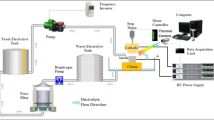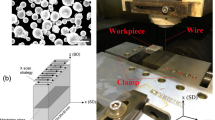Abstract
Metal additive manufacturing offers design freedom, but high surface roughness can limit key properties such as fatigue and pressure drop. Machining all over is a common strategy to mitigate surface roughness, which unfortunately becomes technically and economically prohibitive in the case of significant geometric complexity, e.g., an internal lattice structure. In this paper, a strategy for finishing the surfaces of lattices using the commercial electrochemical machining (ECM) process COOLPULSE is proposed and demonstrated. Inconel 718 lattice coupons and complementing cathode tooling were designed and manufactured via laser powder bed fusion (LPBF). The tooling featured prongs to reach into the core of the lattice coupon in order to establish proximity between cathode and lattice surface (workpiece) as well as ports to allow electrolyte circulation in and around the lattice coupon. Both features extended the electrochemically active region into the core of the workpiece. Inspection of the processed lattice specimens revealed that a significant amount of material was removed from internal surfaces with accompanying improvement in roughness. Depth profiling indicated that the improvement of lattice surface state extended well into the core of the specimen without diminishment, in contrast to an external-only blasting process.




















Similar content being viewed by others
References
Bendsoe MP, Sigmund O (2003) Topology optimization: theory, methods, and applications, 2nd edn. Springer, Berlin
Cheng L, Zhang P, Biyikli E, Bai J, Robbins J, To AC (2017) Efficient design optimization of variable-density cellular structures for additive manufacturing: theory and experimental validation. Rapid Prototyp J 23(4):660–667. https://doi.org/10.1108/RPJ-04-2016-0069
Challis VJ, Xu X, Zhang LC, Roberts AP, Grotowski JF, Sercombe TB (2014) High specific strength and stiffness structures produced using selective laser melting. Mater Des 63:783–788
Shen Y, McKown S, Tsopanos S, Sutcliffe C, Mines R, Cantwell W (2010) The mechanical properties of sandwich structures based on metal lattice architectures. J Sandw Struct Mater 12(2):159–180
Murr L, Gaytan S, Medina F, Lopez H, Martinez E, Machado B, Hernandez D, Martinez L, Lopez M, Wicker R (2010) Next-generation biomedical implants using additive manufacturing of complex, cellular and functional mesh arrays. Philos Trans R Soc A Math Phys Eng Sci 368(1917):1999–2032
Arabnejad S, Johnston B, Tanzer M, Pasini D (2017) Fully porous 3D printed titanium femoral stem to reduce stress-shielding following total hip arthroplasty. J Orthop Res 35(8):1774–1783
Zhu L, Li N, Childs P (2018) Light-weighting in aerospace component and system design. Propul Power Res 7(2):103–119
Tang Y, Dong G, Zhou Q, Zhao YF (2017) Lattice structure design and optimization with additive manufacturing constraints. IEEE Trans Autom Sci Eng 15(4):1–17
Maheshwaraa U, Seepersad CC (2011) Topology design and freeform fabrication of deployable structures with lattice skins. Rapid Prototyp J 17(1):5–16
Brooks H, Brigden K (2016) Design of conformal cooling layers with self-supporting lattices for additively manufactured tooling. Addit Manuf 11:16–22
Weeger O, Boddeti N, Yeung S-K, Kaijima S, Dunn M (2019) Digital design and nonlinear simulation for additive manufacturing of soft lattice structures. Addit Manuf 25:39–49
Lynch ME, Mordasky M, Cheng L, To AC (2018) Design, testing, and mechanical behavior of additively manufactured casing with optimized lattice structure. Addit Manuf 22:462–471. https://doi.org/10.1016/j.addma.2018.05.021
Schaedler TA, Carter WB (2016) Architected cellular materials. Annu Rev Mater Res 46:187–210
Wadley HN (2006) Multifunctional periodic cellular metals. Philos Trans R Soc A Math Phys Eng Sci 364(1838):31–68
Cabanettes F, Joubert A, Chardon G, Dumas V, Rech J, Grosjean C, Dimkovski Z (2018) Topography of as built surfaces generated in metal additive manufacturing: a multi scale analysis from form to roughness. Precis Eng 52:249–265. https://doi.org/10.1016/j.precisioneng.2018.01.002
Stimpson CK, Snyder JC, Thole KA, Mongillo D (2016) Roughness effects on flow and heat transfer for additively manufactured channels. J Turbomach 138(5):051008
Fox JC, Moylan SP, Lane BM (2016) Effect of process parameters on the surface roughness of overhanging structures in laser powder bed fusion additive manufacturing. Procedia CIRP 45:131–134. https://doi.org/10.1016/j.procir.2016.02.347
Cooper DE, Stanford M, Kibble KA, Gibbons GJ (2012) Additive manufacturing for product improvement at Red Bull Technology. Mater Des 41:226–230
Tian Y, Tomus D, Rometsch P, Wu X (2017) Influences of processing parameters on surface roughness of Hastelloy X produced by selective laser melting. Addit Manuf 13:103–112. https://doi.org/10.1016/j.addma.2016.10.010
Saltzman DJ, Bichnevicius M, Lynch SP, Simpson T, Reutzel T, Dickman C, Martukanitz R (2017) Experimental comparison of a traditionally built versus additively manufactured aircraft heat exchanger. In: 55th AIAA Aerospace Sciences Meeting. p 0902
Ventola L, Robotti F, Dialameh M, Calignano F, Manfredi D, Chiavazzo E, Asinari P (2014) Rough surfaces with enhanced heat transfer for electronics cooling by direct metal laser sintering. Int J Heat Mass Transf 75:58–74
Regis M, Marin E, Fedrizzi L, Pressacco M (2015) Additive manufacturing of trabecular titanium orthopedic implants. MRS Bull 40(2):137–144
Weißmann V, Drescher P, Seitz H, Hansmann H, Bader R, Seyfarth A, Klinder A, Jonitz-Heincke A (2018) Effects of build orientation on surface morphology and bone cell activity of additively manufactured Ti6Al4V specimens. Materials 11(6):915
Kirsch KL, Thole KA (2018) Experimental investigation of numerically optimized wavy microchannels created through additive manufacturing. J Turbomach 140(2):021002
Thomas-Seale L, Kirkman-Brown J, Attallah M, Espino D, Shepherd D (2018) The barriers to the progression of additive manufacture: perspectives from UK industry. Int J Prod Econ 198:104–118
Yadollahi A, Shamsaei N (2017) Additive manufacturing of fatigue resistant materials: challenges and opportunities. Int J Fatigue 98:14–31
Lambert DM (2016) Evaluation of the effect of surface finish on high-cycle fatigue of SLM-IN718, NASA report M16–5137
Gockel J, Sheridan L, Koerper B, Whip B (2019) The influence of additive manufacturing processing parameters on surface roughness and fatigue life. Int J Fatigue 124:380–388. https://doi.org/10.1016/j.ijfatigue.2019.03.025
Bagehorn S, Wehr J, Maier H (2017) Application of mechanical surface finishing processes for roughness reduction and fatigue improvement of additively manufactured Ti-6Al-4V parts. Int J Fatigue 102:135–142
Benedetti M, Torresani E, Leoni M, Fontanari V, Bandini M, Pederzolli C, Potrich C (2017) The effect of post-sintering treatments on the fatigue and biological behavior of Ti-6Al-4V ELI parts made by selective laser melting. J Mech Behav Biomed Mater 71:295–306
McCullough K, Fleck N, Ashby M (2000) The stress-life fatigue behaviour of aluminium alloy foams. Fatigue Fract Eng Mater Struct 23(3):199–208
Li S, Murr LE, Cheng X, Zhang Z, Hao Y, Yang R, Medina F, Wicker R (2012) Compression fatigue behavior of Ti–6Al–4V mesh arrays fabricated by electron beam melting. Acta Mater 60(3):793–802
Hrabe NW, Heinl P, Flinn B, Körner C, Bordia RK (2011) Compression-compression fatigue of selective electron beam melted cellular titanium (Ti-6Al-4V). J Biomed Mater Res B Appl Biomater 99(2):313–320
Huynh L, Rotella J, Sangid MD (2016) Fatigue behavior of IN718 microtrusses produced via additive manufacturing. Mater Des 105:278–289
Zhao S, Li S, Hou W, Hao Y, Yang R, Misra R (2016) The influence of cell morphology on the compressive fatigue behavior of Ti-6Al-4V meshes fabricated by electron beam melting. J Mech Behav Biomed Mater 59:251–264
Jamshidinia M, Wang L, Tong W, Ajlouni R, Kovacevic R (2015) Fatigue properties of a dental implant produced by electron beam melting®(EBM). J Mater Process Technol 226:255–263
Dallago M, Winiarski B, Zanini F, Carmignato S, Benedetti M (2019) On the effect of geometrical imperfections and defects on the fatigue strength of cellular lattice structures additively manufactured via selective laser melting. Int J Fatigue 124:348–360
Chern AH, Nandwana P, Yuan T, Kirka MM, Dehoff RR, Liaw PK, Duty CE (2019) A review on the fatigue behavior of Ti-6Al-4V fabricated by electron beam melting additive manufacturing. Int J Fatigue 119:173–184
Greitemeier D, Palm F, Syassen F, Melz T (2017) Fatigue performance of additive manufactured TiAl6V4 using electron and laser beam melting. Int J Fatigue 94:211–217
Denti L, Bassoli E, Gatto A, Santecchia E, Mengucci P (2019) Fatigue life and microstructure of additive manufactured Ti6Al4V after different finishing processes. Mater Sci Eng A 755:1–9
Diaz A (2019) Surface texture characterization and optimization of metal additive manufacturing-produced components for aerospace applications. In: Additive Manufacturing for the Aerospace Industry. Elsevier, pp 341–374
Boschetto A, Bottini L, Veniali F (2018) Surface roughness and radiusing of Ti6Al4V selective laser melting-manufactured parts conditioned by barrel finishing. Int J Adv Manuf Technol 94(5–8):2773–2790
Persenot T, Buffiere J-Y, Maire E, Dendievel R, Martin G (2017) Fatigue properties of EBM as-built and chemically etched thin parts. Procedia Struct Integr 7:158–165
Rajurkar KP, Sundaram M, Malshe A (2013) Review of electrochemical and electrodischarge machining. Procedia CIRP 6:13–26
Ahmadi S, Kumar R, Borisov E, Petrov R, Leeflang S, Li Y, Tümer N, Huizenga R, Ayas C, Zadpoor A (2019) From microstructural design to surface engineering: a tailored approach for improving fatigue life of additively manufactured meta-biomaterials. Acta Biomater 83:153–166
Tan KL, Yeo S-H, Ong CH (2017) Nontraditional finishing processes for internal surfaces and passages: a review. Proc Inst Mech Eng B J Eng Manuf 231(13):2302–2316
Sambharia J, Mali HS (2019) Recent developments in abrasive flow finishing process: a review of current research and future prospects. Proc Inst Mech Eng B J Eng Manuf 233(2):388–399
Yang L, Wu Y, Lassell A, Zhou B (2016) Electropolishing of Ti6Al4V parts fabricated by electron beam melting. In: Proceedings of the International Solid Freeform Fabrication (SFF) Symposium, Austin, TX
Pyka G, Burakowski A, Kerckhofs G, Moesen M, Van Bael S, Schrooten J, Wevers M (2012) Surface modification of Ti6Al4V open porous structures produced by additive manufacturing. Adv Eng Mater 14(6):363–370
Łyczkowska E, Szymczyk P, Dybała B, Chlebus E (2014) Chemical polishing of scaffolds made of Ti–6Al–7Nb alloy by additive manufacturing. Arch Civil Mech Eng 14(4):586–594
Lhuissier P, De Formanoir C, Martin G, Dendievel R, Godet S (2016) Geometrical control of lattice structures produced by EBM through chemical etching: investigations at the scale of individual struts. Mater Des 110:485–493
de Formanoir C, Suard M, Dendievel R, Martin G, Godet S (2016) Improving the mechanical efficiency of electron beam melted titanium lattice structures by chemical etching. Addit Manuf 11:71–76
Van Hooreweder B, Apers Y, Lietaert K, Kruth J-P (2017) Improving the fatigue performance of porous metallic biomaterials produced by selective laser melting. Acta Biomater 47:193–202
Cutolo A, Neirinck B, Lietaert K, de Formanoir C, Van Hooreweder B (2018) Influence of layer thickness and post-process treatments on the fatigue properties of CoCr scaffolds produced by laser powder bed fusion. Addit Manuf 23:498–504
Extrude Hone. https://extrudehone.com/coolpulse-technology-extrude-hone. Accessed 25 Jan 2021
Matt P, Wosniak FA (2019) Method and apparatus for electrolytic polishing and method for fabricating a cathode. Germany Patent DE102016114969A1, 2019
ISO 25178-2 (2012) Geometrical product specifications (GPS) — Surface texture: Areal — Part 2: Terms, definitions and surface texture parameters
Hao L, Raymont D, Yan C, Hussein A, Young P (2011) Design and additive manufacturing of cellular lattice structures. In: The International Conference on Advanced Research in Virtual and Rapid Prototyping (VRAP). Taylor & Francis Group, Leiria. pp 249–254
McMillan M, Jurg M, Leary M, Brandt M (2015) Programmatic lattice generation for additive manufacture. Procedia Technol 20:178–184
Chang P (2011) An improved size, matching, and scaling synthesis method for the design of meso-scale truss structures. Thesis, Georgia Institute of Technology
Abad EMK, Khanoki SA, Pasini D (2013) Fatigue design of lattice materials via computational mechanics: application to lattices with smooth transitions in cell geometry. Int J Fatigue 47:126–136
Acknowledgments
The authors thank Srinivasa Venkatesha, Vitali Weber, Andreas Steiber, and Fabio Wosniak of Extrude Hone for assistance with design, simulation, visualization, and processing; Luke Moran, Ray Amin, and Jay Tomko of Extrude Hone, Jesse Boyer of Pratt & Whitney, Jackie Garofano of Raytheon Technologies, and Anthony Ventura of RTRC for helpful discussion; and Justina Leung of RTRC for assistance with measurements.
Author information
Authors and Affiliations
Corresponding author
Additional information
Publisher’s note
Springer Nature remains neutral with regard to jurisdictional claims in published maps and institutional affiliations.
Rights and permissions
About this article
Cite this article
Lynch, M.E., Williams, K., Cabrera, M. et al. Surface finishing of additively manufactured IN718 lattices by electrochemical machining. Int J Adv Manuf Technol 113, 967–984 (2021). https://doi.org/10.1007/s00170-020-05699-8
Received:
Accepted:
Published:
Issue Date:
DOI: https://doi.org/10.1007/s00170-020-05699-8




